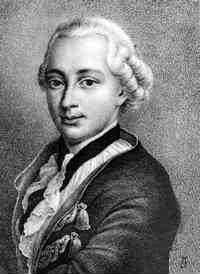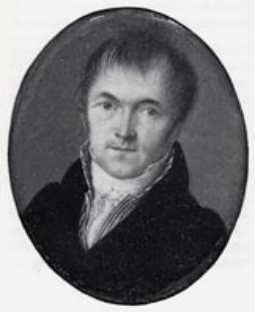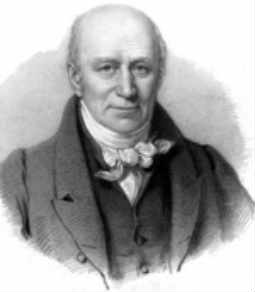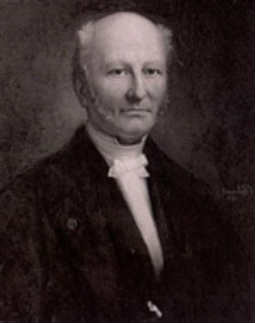On the Origins of New Forms of Life
1.5: Creationism vs. Hybridization
(Continued from the previous page)
 Kölreuter
Kölreuter
Creationism continued as the majority view. Its adherents still embraced the notion of a divinely regulated natural order, and therefore opposed Linnaeus. In particular, Joseph Gottlieb Kölreuter (1733-1806) doggedly opposed Linnaeus' theory. In a shower of reports published over a twenty-eight-year period (1761-1788),¹ he set forth the results of hundreds of hybridization experiments.
Mayr (1982: 645) says Kölreuter's "basic objective was to prove that hybridization of two species does not produce a third species." The ultimate motive underpinning that objective was of a religious nature. Callender (1988: 44) says Kölreuter considered Linnaeus' theory "as subversive of the doctrine of Special Creation." Kölreuter's own words show he believed in a provident Nature that always took care to prevent natural hybridization:
Kölreuter's objections. Kölreuter claimed two phenomena refuted Linnaeus' theory.³ First, he had noticed that some hybrids, when self-fertilized, produce progeny more similar to one or the other of their original parental forms than to the hybrid itself. On this basis he surmised (but did not directly observe) that later-generation hybrids would eventually become perfectly similar to the original forms. In subsequent literature this supposed phenomenon was called "reversion." Modern research has shown that while some hybrids, from some crosses, do exhibit such a tendency, there is no rule of the rigid sort Kölreuter alleged. Some hybrids show such a tendency. Others don't.
Second, he had observed that when the hybrids derived from a cross are mated in each subsequent generation, not with each other, but always with one of the two parental forms originally producing them, they became more and more like that form with each succeeding generation. After many generations, they became indistinguishable. He called this the "transformation" of one parent into the other. Because he believed pollen derived from parental forms to be more potent than that derived from hybrids, he concluded that any naturally occurring hybrids would be subjected to an ongoing natural process that would transform them back into their parents. But this was merely a surmise, in no way based on the observation of natural populations and says nothing about hybrids produced in some other way.
In fact, as we shall see, many stable natural hybrids are known. Kölreuter's claims were, however, accepted and widely cited by naturalists who defended the notions of immutability and Special Creation.
 von Gärtner
von Gärtner Knight
Knight Lecoq
Lecoq
Gärtner. An even more sedulous member of the conservative faction was Carl Friedrich von Gärtner (1772-1850). He, too, sought to squelch Linnaeus' heresy through the assiduous hybridization of plants. As a young man he was a close family friend of Kölreuter's and like him sought experimental support for Special Creation.⁴ In 1800, he closed shop as a medical doctor and devoted the remainder of his life to botany. From about 1824 until his death he studied plant hybrids. He eventually published the results of nearly 10,000 crossing experiments, in his Versuche und Beobachtungen über die Bastarderzeugung im Pflanzenreich (1849). Gärtner saw his work as a test of alternative hypotheses, Special Creation and Linnaeus' theory of evolution through hybridization (Callender 1988). He seems to have been driven by an awareness that many scientists accepted Linnaeus' views. As he notes himself in the introduction to his book,
The men he mentions were all leading botanists of the era. Thomas Andrew Knight was long president of the London Horticultural Society (later the Royal Horticultural Society) from 1811 to 1838 and is generally considered the most distinguished horticulturist of his day. It is no surprise he believed hybridization could produce new forms. He had developed many new types of fruit by such means himself. In the first half of the nineteenth century, William Herbert (1778-1847) was the foremost English authority on plant hybridization.⁶ Among botanists, he was renowned as the author of the monumental Amaryllidaceae (1837). Ludwig Reichenbach⁷ and Henri Lecoq⁸ were both prolific authors of botanical literature and directors of important scientific institutions. Olby (1997) argues even Gregor Mendel's
(This certainly isn't the Mendel we hear about in biology and genetics classes!) Thus, Linnaeus' theory was still taken quite seriously a century after he had conceived it. Even Mendel (1822-1884), a younger man than Darwin, was apparently influenced by it.
Darwin, Creationism, and Hybrid Sterility. Darwin, of course, labored long and hard against creationism and the idea of immutability. So he did his best to undermine the idea that God specially endows hybrids with sterility. In the eighth chapter of the Origin, he argues that the complexity and inconsistency of the rules of hybridization speak against the idea that hybrid sterility is God's way of preventing the blending of distinct types of organisms. After discussing available data on hybridization, he writes (1859: 260):
Like other naturalists of the time, Darwin took this issue quite seriously -- elsewhere he commented that "if it could be proved or rendered highly probable that sterility in the first cross or in the hybrid offspring was a specially created endowment, it would be to us a fatal difficulty."⁹ However, in his theory Darwin did not pursue the implications of the fact that many hybrids are not sterile. He merely used the known facts about hybridization, in particular the fact that different types of hybrids display different degrees of fertility, to undermine creationism. Giving scant attention to hybridization as a means of producing new types of organisms, he largely ignored Linnaeus' claims that evolution happened in that way. As a result, the ascendancy of his theory put such ideas in the shade. There they remained for the next forty years, although a few scientists (e.g., Kerner 1871, 1894-1895) did continue to argue that hybridization could produce new types of organisms. Not until Hugo de Vries (1901, 1903) published his theories did such ideas again reach the forefront of evolutionary debate.
Modern neo-Darwinism has retained creationism's old idea of insurmountable barriers even while discarding the allied notion of immutability. It envisions new types of organisms arising via a process in which they gradually change. But that change is supposed to occur only within isolated populations, ones that do not interbreed. Under that view, barriers preventing interbreeding are presumed to be necessary if populations are to differentiate, by gradually accumulating differences, and not blend back together. This view ignores the great mass of evidence demonstrating that a wide variety of organisms produce hybrids in a natural setting, that such hybrids occur in large numbers, and that they often are not sterile. A very small portion of this evidence will be discussed in subsequent sections. NEXT PAGE >>
1. See Kölreuter (1761-1766) and additional papers cited in Schiede (1825: 12).
2. Kölreuter (1761-1766) in Ostwald's Klassiker der exakten Wissenschaften, no. 35, p. 29. (1893, Leipzig: Wilhelm Engelmann). Translated by E. M. McCarthy. Original German: "So unwahrscheinlich es ist, dass von zwoen verschiedenen Gattungen von Thieren, die in ihrer natürlichen Freyheit gelebt, jemals ein Bastart erzeugt worden, so unwahrscheinlich ist es auch, dass bey der ordentlichen Einrichtung, die die Natur bey dem Pflanzenreiche gemacht hat, eine Bastartpflanze entstanden sey. Die Natur, die jederzeit, auch bey der grössesten scheinbaren Unordnung, die schönste Ordnung beobachtet, hat dieser Verwirrung bey den wandelnden Thieren ausser andern Mitteln hauptsächlich durch die natürlichen Triebe vorgebeuget, und bey den Pflanzen , bey denen ihre allzu nahe Nachbarschaft, der Wind und Insekten zu einer widernatürlichen Vermischung täglich Gelegenheit geben, wird sie denen davon zu besorgenden Wirkungen ohne Zweifel durch eben so sichere Mittel ihre Kraft zu benehmen gewusst haben. Vermuthlich sind es eben dieselben, die bey den Thieren, ausser den natürlichen Trieben, statt finden."
3.Callender (1988: 45-46).
4. Callender (1988: 46).
5. Gärtner (1849: 14-15). Translated by E. M. McCarthy. Original German: "Die Bastardbefruchtung wird noch in neuester Zeit von mehreren Botanikern als Plan und Zweck der Natur betrachtet, besonders von solchen, welche glauben, dass artenreiche Gattungen nur auf dem Wege der Bastardzeugung haben entstehen können, wie Knight, W. Herbert, H. Lecoq, L. Reichenbach, u. m. a. [und mehere andere]. ... Schon Kölreuter hat diese Hypothese bestritten, und es wird sich im weiteren Verlauf unserer Untersuchung über die Natur der Bastarde ergeben, dass das Wesen der reinen Art dieser Annahme widerspricht."
6. Darwin (1872: xv) comments that "the Hon. and Rev. W. Herbert, ... believes that single species of each genus were created in an originally highly plastic condition, and that these have produced, chiefly by intercrossing, but likewise by variation, all our existing species."
7. Heinrich Gottlieb Ludwig Reichenbach (1793-1879). German botanist and ornithologist. The director of the Dresden Natural History Museum, founder of the Dresden botanical gardens, and joint founder of Dresden zoo. A prolific author and skilled botanical artist, his major work was the 10-volume Iconographia Botanica seu Plantae criticae (1823-1832).
8. Henri Lecoq (1802-1871). French botanist. Director of the Clermont-Ferrand Botanical Gardens. His publications include Principes élémentaires de botanique (1828), Étude de la géographie botanique de l'Europe (1854), and Botanique populaire (1862).
9. See: Stauffer (1987: 390).
Most shared on Macroevolution.net:
Human Origins: Are we hybrids?
On the Origins of New Forms of Life
Mammalian Hybrids
Cat-rabbit Hybrids: Fact or fiction?
Famous Biologists
Dog-cow Hybrids
Georges Cuvier: A Biography
Prothero: A Rebuttal
Branches of Biology
Dog-fox Hybrids
Creationism versus hybridization - © Macroevolution.net